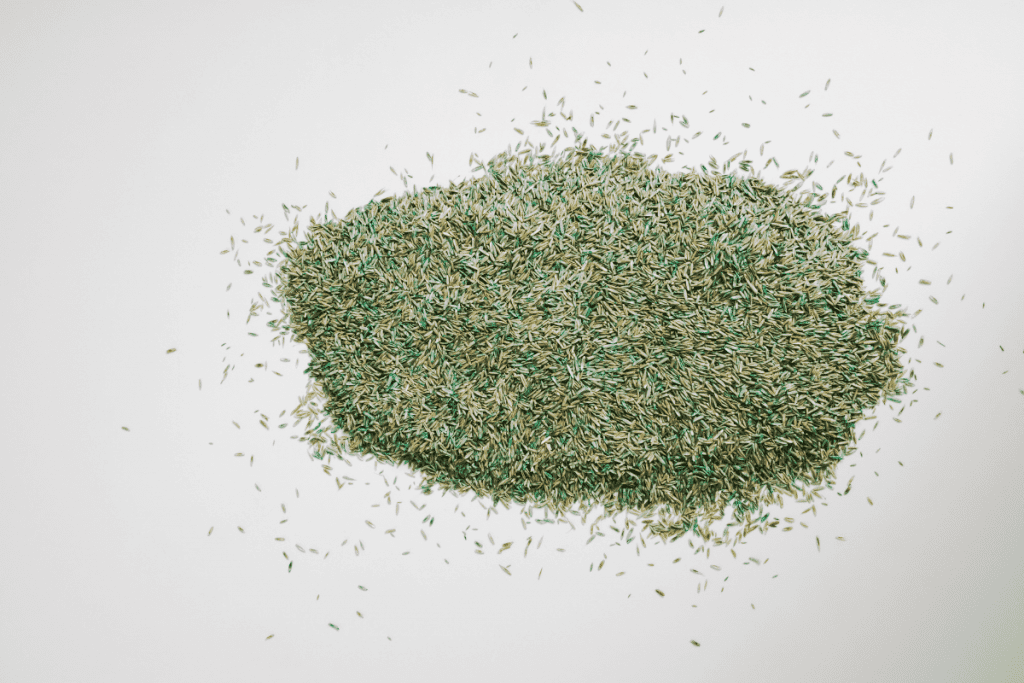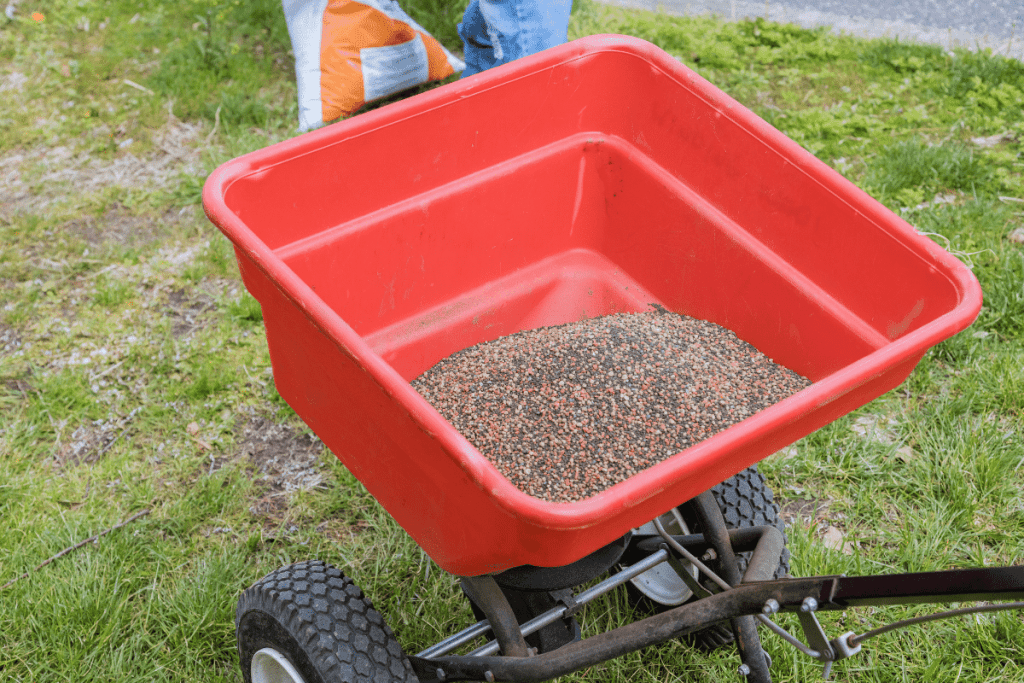Whether growing grass from seed for a new lawn or overseeding an existing one, it is essential to plant the right amount of grass seed.
Planting too much or too little grass seed will not give you the best results, so it is best to research and prepare ahead of time.
So how do you determine how much grass seed to plant on your lawn?
As a general rule, you will plant 2-8 pounds of grass seed for every 1,000′ square feet. The exact amount of grass seed you plant will depend on the size of your yard, the grass type, the weather, and the project’s overall scope.
If you are planting a new lawn, you will need more grass seed than you will if you oversee a patchy lawn.
Read on to learn more about how to measure your lawn and calculate the amount of grass seed you will need to purchase for your lawn project.

Table of Contents
Seeding Rates Per Type Of Grass
Different types of cool-season and warm-season grasses have varying application rates.
These rates will range from 1-2 pounds of seed per 1,000′ square feet to 9-10 pounds per 1,000′ square feet.
What may be an adequate application rate for one type of grass may not be enough for a different grass type.
The application rates are usually listed on the grass seed bag, but it may be confusing if you are only overseeding instead of planting a whole new lawn.
The overseeding rate will usually be half of the rate of planting a new lawn.
To prevent further confusion, the following table illustrates the application rates for the most popular grass types based on whether you are seeding a new lawn or overseeding an existing one.
St. Augustine grass is not included on this table because it is typically installed as sod rather than being grown from seeds.
| Grass Type | Overseeding Rate | New Lawn Rate |
|---|---|---|
| Perennial Ryegrass | 5-6 lbs. for 1,000’ sq. ft. | 9-10 lbs. for 1,000’ sq. ft. |
| Kentucky Bluegrass | 1-2 lbs. for 1,000’ sq. ft. | 2-3 lbs. for 1,000’ sq. ft. |
| Tall Fescue | 4-5 lbs. for 1,000’ sq. ft. | 8-10 lbs. for 1,000’ sq. ft. |
| Bahia | 4-5 lbs. for 1,000’ sq. ft. | 7-10 lbs. for 1,000’ sq. ft. |
| Bermuda Grass | 0.75-1.25 lbs. for 1,000’ sq. ft. | 1.5-2.5 lbs. for 1,000’ sq. ft. |
| Centipede | 0.5 lb. for 1,000’ sq. ft. | 1 lb. for 1,000’ sq. ft. |
| Zoysia | 1 lb. for 1,000’ sq. ft. | 2 lbs. for 1,000’ sq. ft. |
Which Factors Determine How Much Grass Seed To Plant?
Several factors affect the quantity of grass seed you need to plant for a lush lawn.
Consider these factors before planting your grass seed, or you may end up with patchy areas and poor grass growth.
Doing your research ahead of time will save you from having severe issues with your lawn later.
Different Grass Seed Types
The type of grass seed you are planting will determine how many seed bags you need to purchase.
Knowing which grass seed type thrives in your area is crucial if you strive for a beautiful lawn.
Warm-season grasses, such as St. Augustine, zoysia, and Bermuda grass, will thrive in warmer climates, and most of these grass types are not tolerant to frost.
You can check out our list of the best Bermuda grass seed here.
Cool-season grasses like perennial ryegrass, Kentucky bluegrass, and fescue grasses grow well in cooler climates and die out in extreme heat or drought conditions.
Many seed bags also include fillers, coatings, and other inert materials formulated to encourage seeds to establish themselves.
Seed coatings allow seeds to germinate faster and retain moisture, so they do not dry out quickly.
Other seed bags will mix the filler material with the seeds, such as soil or peat moss.
While these filler materials help the grass seeds establish proper contact with the soil to promote germination, they also add unnecessary weight and cost to your grass seed bag.
Most grass seed bags will have a label with information on the seed application rate.
This rate will be based on the type of seed and the filler materials included in the bag.
As long as you know the size of your lawn, these labels will help you determine how many bags of seed you need to purchase as well as the proper application rate.
The Amount of Sunlight on Your Lawn
Whether your lawn is in a shady or sunny location will also affect the germination of your grass seeds.
If you have poor germination, you may need to purchase and plant more seeds later.
The soil’s surface and the seeds need to stay moist for the seeds to germinate properly.
To maintain the moisture in your soil and seeds, you will likely have to water your lawn several times a day.
Even after the seeds germinate, you will still need to stick to a frequent watering schedule until the grass starts to fill in.
Keeping your grass seeds and soil moist will be more challenging if your lawn receives a lot of sunlight.
In areas of constant sunlight, it is wise to plant more grass seeds than you usually would because not all of the seeds will fully germinate.
It is easy for grass seeds to germinate in shady areas because the soil is not receiving too much harsh sunlight to dry them out.
Shady parts of your lawn also tend to be more protected from wind and heavy rain as well.
The Scope of the Project
The size of your yard and whether or not you are seeding a new or existing lawn has a lot to do with how much grass seed you will plant.
Reseeding a lawn takes around half as much grass seed as you would need to establish a whole new lawn.
If your lawn is already thick and you only want to add a new grass type, you will not need a lot of seeds.
However, if there are several bare spots or patchy areas of your lawn you need to fix, it will need to be heavily overseeded.
If there is a lot of thatch on your lawn, you will have to plant more grass seeds for proper soil contact, but it is better to remove the thatch and plant a normal amount of seeds.
Calculating The Size Of Your Lawn

One of the biggest mistakes homeowners make when determining how much grass seed they need is not measuring their lawn correctly.
Not having the proper measurements for your lawn will cause you to buy too much or too little grass seed.
Getting the right measurements for your lawn before you purchase the grass seed will save you a lot of time and money in the long run.
Most application rates for grass seed are based on the square footage of your lawn.
Start by measuring the length and width of your lawn in feet, then multiply these numbers together to get the square footage.
Subtract areas such as your driveway, garden beds, patio, or sidewalk for a more precise lawn measurement.
It will be much easier to buy the correct amount of grass seeds with the correct lawn measurements.
If your bag of grass seed includes a range of square footage in the application rate, use the lower end of the range for overseeding and the higher end of the range for planting an entirely new lawn.
If you have a large area of grass, such as an acre, you will need to calculate your measurements a bit differently.
There are 43,560′ square feet in an acre, and since most grass seed application rates are pounds per 1,000′ square feet, you will divide 43,560 by 1,000 to get 43.56.
If the instructions on your grass seed say to use three pounds per 1,000′ square feet, you will multiply 43.56 by 3 for 130.68, which means you will need around 131 pounds of grass seed to cover an acre.
Does The Season Or Climate Affect The Seed Application Rate?
Seeding your lawn during the right season and weather conditions is extremely important if you want your grass to thrive.
For example, if you plant cool-season grass at the start of the summer season, the extreme heat and dryness will cause the grass to have issues germinating and forming strong roots.
It is better to plant cool-season grass in the early fall because the soil will be warm, and the cooling temperatures will aid in germination and healthy root growth.
Likewise, warm-season grass will not thrive in areas prone to frost, so it is better to plant it in the late spring or early summer when soil temperatures are consistently above 65° degrees Fahrenheit (18° C).
Understanding the grass type for your area and sowing your grass seeds at the correct time of year is an important first step in creating a lush, healthy lawn.
What Happens If You Sow Too Much Grass Seed?
When it comes to planting grass seeds, less is more.
Sowing too many grass seeds means the new grass will have to compete for water, nutrients, and sunlight.
As a result, many grass seeds may not even germinate because they will not receive enough resources to thrive.
Putting down too much grass seed also makes it more difficult to even apply.
You will end up with a patchy lawn with uneven growth, and it may be more prone to having weeds.
Always follow the directions on your bag of grass seed as a guide for the best application rate, and be sure to spread the seeds evenly.
If your lawn is not as lush and thick as you would like when it finally grows in, it is always possible to come back the next year and add some extra seed to it.
Did you know grass seed can go bad?
Check out our article on how long grass seed may be stored safely.
How To Plant Grass Seed

Planting your grass seed correctly will make it much easier for you to grow the lush, green lawn you have always wanted.
Timing and soil preparation are critical elements in creating a healthy lawn.
Fertilization also plays a key role in the overall health of your grass.
The steps below outline what you need to do to grow grass from seeds successfully.
Choose the Right Time
As previously stated, timing is everything when planting grass seeds.
If the soil is too warm or too cold, your seeds will not germinate, and all of your efforts will be wasted.
The ideal soil temperature for planting seeds ranges from 50-80° degrees Fahrenheit (27° C).
Always plant cool-season and warm-season grasses at the proper time of year to ensure successful growth.
As a general rule, it is best to plant cool-season grasses in the late summer or early fall, and warm-season grasses need to be planted in late spring to early summer.
It is crucial to plant the correct grass type for your climate for a successful outcome.
Prepare the Soil
Soil preparation is another important and often overlooked step when planting grass seeds.
If your lawn is covered in thatch or your soil is tightly compacted, these issues need to be addressed before sowing any seeds.
Excess thatch prevents the seeds from making proper contact with the soil.
Use a dethatching tool to thoroughly remove areas of thatch before you start planting your grass seeds.
Compacted soil is another issue, but it is easy to fix.
If the soil is packed too tightly, it will be very difficult for your grass seeds to establish a strong root system.
Use a core aerator to loosen the compacted soil, allowing better drainage and healthy root growth.
You may also want to check out our article on how to plant grass seeds on hard dirt.
Plant the Seeds
Planting your grass seeds evenly prevents any patchy areas in your lawn.
Divide your seeds in half and use a broadcast spreader to sow half of the seeds in one direction on your lawn, such as east to west.
After making the first pass, spread the second half of your seeds in the other direction, such as north to south.
This ensures all areas of your lawn are covered in a nice even layer of seeds, and it lessens the possibility of your lawn having patchy or bare spots once the grass grows in.
Once the seeds have been evenly spread, use a lawn rake to gently cover your seeds with around 1/4″ inches of soil.
Covering your grass seeds with a thin layer of soil prevents the seeds from being blown or washed away by inclement weather.
Fertilize the Seeds
After the seeds have been spread and raked into the soil, it is important to water the area thoroughly.
Take care not to over-water, though.
The ground needs to have enough moisture to not dry out easily, but there should not be puddles of standing water on your lawn, either.
You will need to water your lawn 2-3 times per day for the first few weeks after planting the grass seeds.
Seed germination varies based on the type of grass and will range anywhere from 7-14 days to as much as 21-28 days.
Once the grass is at least 3″ inches tall, you may reduce the watering sessions to 2-3 times per week.
In addition to watering the seeds, it is best to use a starter fertilizer to give the grass a boost of nutrients for healthy growth.
Follow the directions on the fertilizer label to prevent causing any ill effects to your lawn.
Applying too much fertilizer will cause your grass to turn yellow and have a burned appearance.
This type of lawn damage is very time-consuming and expensive to fix.
If you have issues with your grass seed, check out our post on steps to take if grass seed isn’t growing.
Maintain Your New Lawn
Once your grass is around 4″ inches tall, you may mow your lawn for the first time.
Always follow the one-third rule of mowing and never cut more than one-third of the length of the grass blade at one time.
Cutting your lawn too short will cause the grass to become dry more easily, and you may end up with patchy areas and bare spots.
An established lawn will need between 1-1.5″ inches of water every week.
This water total includes rainfall, so keep this in mind when you water your lawn.
It is also important to regularly fertilize your grass throughout the year to maintain strong growth and a healthy root structure.
Be sure to follow the instructions on your fertilizer label to avoid overdoing it, as too much fertilizer will cause your grass to burn and become discolored.
Commonly Asked Questions
Do you need to put soil over grass seed?
As long as your soil is aerated and has the proper pH level, you do not need to purchase new soil to go over the top of your newly planted grass seed.
Gently raking 1/4″ inch of existing soil over the seeds once they have been planted will be enough to keep them from being blown away or washed out.
Does grass seed need to be watered daily?
Newly planted grass seed must be watered at least twice per day until the grass begins to sprout and fill in.
Once the grass has sprouted above the soil, you may reduce watering to once per day until the lawn is established.
You will only need to water an established lawn around once per week with normal rainfall.
How long does it take for 3″ inches of grass to grow?
Depending on temperatures, it will take grass close to 30 days to grow up to 3″ inches.
In cooler weather, it may take longer to see noticeable results.
Why do you put straw over grass seed?
A thin layer of straw is spread over newly-planted grass seeds to keep the soil moist and protect the seedlings.
This straw layer ensures the successful growth of your grass seeds.
It is important to use straw instead of hay because hay contains seeds that will produce weeds on your lawn.